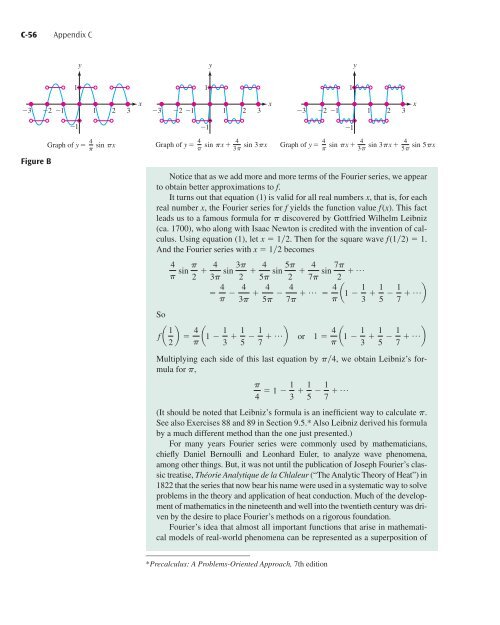You also want an ePaper? Increase the reach of your titles
YUMPU automatically turns print PDFs into web optimized ePapers that Google loves.
C-56 Appendix C<br />
y<br />
y<br />
y<br />
1<br />
1<br />
1<br />
-3<br />
-2 -1<br />
1 2 3<br />
x x x<br />
-3 -2 -1 1 2 3 -3 -2 -1 1 2 3<br />
-1<br />
4<br />
Graph of y= sin πx<br />
π<br />
Figure B<br />
4<br />
4<br />
4<br />
4<br />
4<br />
Graph of y= sin πx+ sin 3πx Graph of y= sin πx+ sin 3πx+ sin 5πx<br />
π 3π<br />
π 3π<br />
5π<br />
Notice that as we add more and more terms of the Fourier series, we appear<br />
to obtain better approximations to f.<br />
It turns out that equation (1) is valid for all real numbers x, that is, for each<br />
real number x, the Fourier series for f yields the function value f(x). This fact<br />
leads us to a famous formula for p discovered by Gottfried Wilhelm Leibniz<br />
(ca. 1700), who along with Isaac Newton is credited with the invention of calculus.<br />
Using equation (1), let x 12. Then for the square wave f(12) 1.<br />
And the Fourier series with x 12 becomes<br />
So<br />
-1<br />
4<br />
p sin p 2 4<br />
3p sin 3p 2 4<br />
5p sin 5p 2 4<br />
7p sin 7p 2 p<br />
4 p 4<br />
3p 4<br />
5p 4<br />
7p p 4 p a1 1 3 1 5 1 7 p b<br />
-1<br />
f a 1 2 b 4 p a1 1 3 1 5 1 7 p b<br />
or<br />
1 4 p a1 1 3 1 5 1 7 p b<br />
Multiplying each side of this last equation by p4, we obtain Leibniz’s formula<br />
for p,<br />
p<br />
4 1 1 3 1 5 1 7 p<br />
(It should be noted that Leibniz’s formula is an inefficient way to calculate p.<br />
See also Exercises 88 and 89 in Section 9.5.* Also Leibniz derived his formula<br />
by a much different method than the one just presented.)<br />
For many years Fourier series were commonly used by mathematicians,<br />
chiefly Daniel Bernoulli and Leonhard Euler, to analyze wave phenomena,<br />
among other things. But, it was not until the publication of Joseph Fourier’s classic<br />
treatise, Théorie Analytique de la Chlaleur (“The Analytic Theory of Heat”) in<br />
1822 that the series that now bear his name were used in a systematic way to solve<br />
problems in the theory and application of heat conduction. Much of the development<br />
of mathematics in the nineteenth and well into the twentieth century was driven<br />
by the desire to place Fourier’s methods on a rigorous foundation.<br />
Fourier’s idea that almost all important functions that arise in mathematical<br />
models of real-world phenomena can be represented as a superposition of<br />
*Precalculus: A Problems-Oriented Approach, 7th edition
















